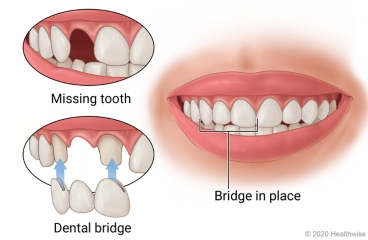
What is restorative dentistry?
The purpose of restorative dentistry is to repair damaged teeth or replace missing ones. The goal is to save teeth and to provide teeth that look, feel, and work like natural teeth. The restored teeth also help keep your other teeth spaced correctly for a normal bite.
Common types of restorative dentistry are fillings, crowns, bridges, dentures, and dental implants.
What are some types of restorative dentistry?
Common types of restorative dentistry are:
- Fillings. A filling fixes a hole, or cavity, in the hard outer layers of a tooth. Cavities are caused by tooth decay. If the decay isn't treated, it can cause pain, infection, and tooth loss. The dentist removes the decay and replaces it with a filling. Fillings can be made from many types of material, including metals and resins.
- Crowns. A crown (cap) fits over a tooth above the gum line. It's often used when the original tooth is too damaged to be repaired with a filling. A crown can seal the tooth and keep it from breaking. The dentist shapes the existing tooth to make room for the crown. The crown may be made of material that matches the teeth, or it may be made of gold or another material. It is shaped to match your old tooth. The dentist fits the crown over the tooth and cements it into place. Crowns sometimes come loose or wear out over time. They may need to be cemented again or replaced.
- Bridges. A bridge replaces a missing tooth. It's usually made up of the replacement tooth and a crown on each side. All three parts are cemented together so that the crowns support the new tooth. The dentist first shapes the teeth on both sides of the missing tooth. The crowns then fit over the prepared teeth to support the new tooth. Sometimes a bridge contains more than one replacement tooth. The crowns in a bridge may need to be cemented again or replaced if they come loose or wear out.
- Partial dentures. A partial denture replaces more than one tooth in a row. The replacement teeth are held in place by wires attached to existing teeth. A partial denture can be removed for cleaning and teeth brushing and flossing.
- Dental implants. A dental implant is an artificial root topped with a crown. An oral surgeon places a metal anchor in the jawbone. The anchor acts as the tooth's root. A post is attached to the anchor, either at the same time that the anchor is placed, or at a later appointment. The post extends out of the anchor, above the gum line. In 3 to 6 months, the bone grows around the anchor and holds it tight. A crown is then cemented to the post. The gums and bone must be healthy enough to support the implant.
How can you care for your teeth and gums?
It is just as important to brush and floss fillings, crowns, bridges, partial dentures, and implants as it is with natural teeth. Flossing around the gums is important, too. Plaque, a sticky film of bacteria, can build up on gums and dental work. If plaque isn't removed, it can build up and harden into tartar. The bacteria in plaque and tartar can cause gum infections like gingivitis and periodontal disease.
Will insurance pay for this treatment?
Restorative dentistry can cost a lot. Dental or medical insurance plans may or may not cover some of the cost. Before starting treatment, make sure you know how much it will cost and how you'll pay for it. Your dentist may offer payment plans that can help you fit the expense into your budget.
Follow-up care is a key part of your treatment and safety. Be sure to make and go to all appointments, and call your dentist if you are having problems. It's also a good idea to know your test results and keep a list of the medicines you take.
Where can you learn more?
Go to http://www.healthwise.net/patientEd
Enter J910 in the search box to learn more about "Learning About Restorative Dentistry".
Current as of: September 30, 2025
Author: Ignite Healthwise, LLC Staff
Clinical Review Board
All Ignite Healthwise, LLC education is reviewed by a team that includes physicians, nurses, advanced practitioners, registered dieticians, and other healthcare professionals.

